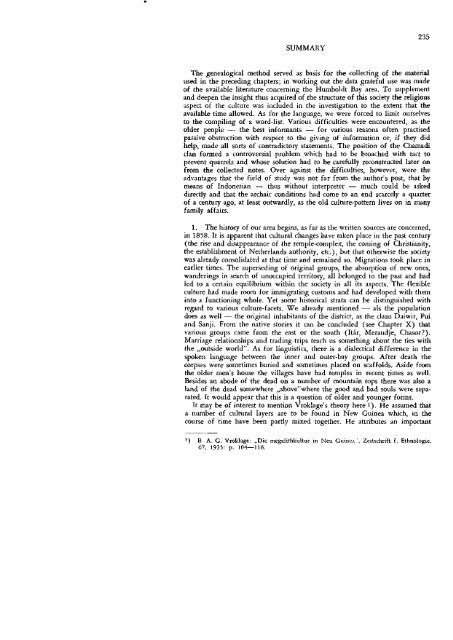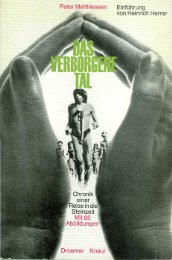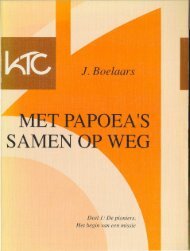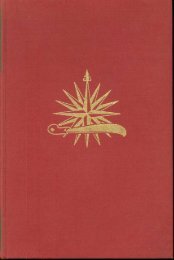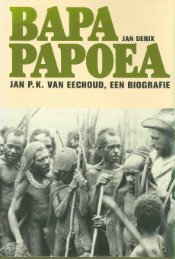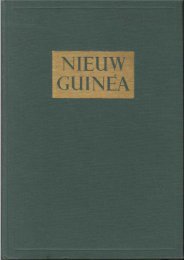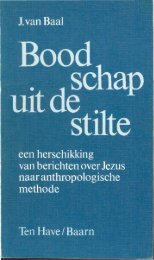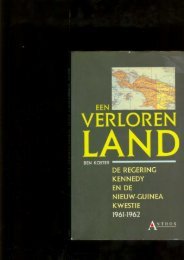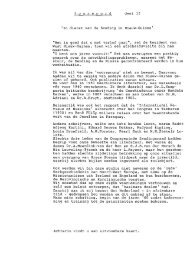Untitled - Stichting Papua Erfgoed
Untitled - Stichting Papua Erfgoed
Untitled - Stichting Papua Erfgoed
You also want an ePaper? Increase the reach of your titles
YUMPU automatically turns print PDFs into web optimized ePapers that Google loves.
SUMMARY<br />
235<br />
The genealogical method served as basis for the collecting of the material<br />
used in the preceding chapters; in working out the data grateful use was made<br />
of the available literature concerning the Humboldt Bay area. To supplement<br />
and deepen the insight thus acquired of the structure of this society the religious<br />
aspect of the culture was included in the investigation to the extent that the<br />
available time allowed. As for the language, we were forced to limit ourselves<br />
to the compiling of a word-list. Various difficulties were encountered, as the<br />
older people — the best informants — for various reasons often practised<br />
passive obstruction with respect to the giving of information or, if they did<br />
help, made all sorts of contradictory statements. The position of the Chamadi<br />
clan formed a controversial problem which had to be broached with tact to<br />
prevent quarrels and whose solution had to be carefully reconstructed later on<br />
from the collected notes. Over against the difficulties, however, were the<br />
advantages that the field of study was not far from the author's post, that by<br />
means of Indonesian — thus without interpreter — much could be asked<br />
directly and that the archaic conditions had come to an end scarcely a quarter<br />
of a century ago, at least outwardly, as the old culture-pattern lives on in many<br />
family affairs.<br />
1. The history of our area begins, as far as the written sources are concerned,<br />
in 1858. It is apparent that cultural changes have taken place in the past century<br />
(the rise and disappearance of the temple-complex, the coming of Christianity,<br />
the establishment of Netherlands authority, etc.), but that otherwise the society<br />
was already consolidated at that time and remained so. Migrations took place in<br />
earlier times. The superseding of original groups, the absorption of new ones,<br />
wanderings in search of unoccupied territory, all belonged to the past and had<br />
led to a certain equilibrium within the society in all its aspects. The flexible<br />
culture had made room for immigrating customs and had developed with them<br />
into a functioning whole. Yet some historical strata can be distinguished with<br />
regard to various culture-facets. We already mentioned — als the population<br />
does as well — the original inhabitants of the district, as the clans Daiwir, Pui<br />
and Sanji. From the native stories it can be concluded (see Chapter X) that<br />
various groups came from the east or the south (Itár, Meraudje, Chasor?).<br />
Marriage relationships and trading trips teach us something about the ties with<br />
the „outside world". As for linguistics, there is a dialectical difference in the<br />
spoken language between the inner and outer-bay groups. After death the<br />
corpses were sometimes buried and sometimes placed on scaffolds. Aside from<br />
the older men's house the villages have had temples in recent times as well.<br />
Besides an abode of the dead on a number of mountain tops there was also a<br />
land of the dead somewhere „above"where the good and bad souls were separated.<br />
It would appear that this is a question of older and younger forms.<br />
It may be of interest to mention Vroklage's theory here 1 ). He assumed that<br />
a number of cultural layers are to be found in New Guinea which, in the<br />
course of time have been partly mixed together. He attributes an important<br />
1 ) B A. G. Vroklage: „Die megalithkultur in Neu Guinea', Zeitschrift f. Ethnologie,<br />
67, 1935: p. 104—116.


